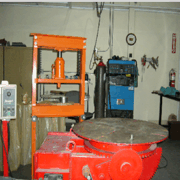GMAW and SMAW Welding for Aerospace Applications
SMAW Welding
SMAW is short for “Shielded Metal Arc Welding.” Also sometimes called “stick” welding. This is because it uses an electrode, which is shaped like a stick. During the welding process, this electrode is melted together with the metal that is being welded.

This creates what’s known as a “weld pool.” This weld pool must be carried along the joint in a consistent manner to create a stronghold and join the metal together permanently. Because the rod-shaped electrode is consumed while welding, it must be changed regularly, and may even need to be swapped during a welding job.
SMAW welding provides the strongest hold out of any welding method and is good for most construction and industrial applications, as it can be used on almost all metals of varying thicknesses.
Another benefit of SMAW welding is that it can be done in just about any type of weather, as long as the metal is above 0 degrees Fahrenheit, and the welded material is kept safe from rain, snow and blowing sand.
GTAW (Tungsten Inert Gas) Welding
GTAW is short for Gas Tungsten Arc Welding and is also sometimes called TIG (Tungsten Inert Gas) welding. This type of welding uses a tungsten electrode to deliver the electric arc. The tungsten can withstand extremely high temperatures, so it does not melt, and it is not consumable, unlike SMAW and GMAW.
This means that a “filler metal” must be used to melt and create the weld pool which allows the metals to be joined together. The proper fill metal depends on the material, thickness, and a number of other factors.
GTAW can create extremely clean, pleasing-looking welds, and the welder has unparalleled control over the weld, making it ideal for applications where the weld will be visible and must be clean and appealing.
It also does not produce sparks, fumes, smoke, or slag, and can be used on metals of any thickness. It’s often used in shipbuilding, automotive, and aerospace applications.
GMAW (Metal Inert Gas) Welding
Gas Metal Arc Welding (GMAW) is also sometimes known as Metal Inert Gas (MIG) welding, though MIG is actually a specific subtype of GMAW.
This method of welding uses a long spool of wire-fed consumable electrode, which melts together with the metal to create a weld pool. Because the electrode is always melting and delivering a constant stream of weld, this helps prevent contamination and messy welding. A separate tank of gas helps shield and prevent contamination of the weld site, hence the term “gas metal arc welding.)
This method of welding is typically considered to be the easiest to learn, as it’s easy to control the speed of the wire electrode, and you do not have to stop to swap it out regularly, unlike SMAW welding, and you don’t need to feed a filler metal, unlike GTAW welding.
This also means that GMAW is one of the most efficient methods of welding. It can be used to quickly join a number of metal parts with very minimal downtime. However, GMAW equipment is quite expensive, compared to other types of welding equipment, and the larger size of a GMAW welding “gun” can make it difficult to work in tight spaces.
Knowing Which One to Use
There are many different types of welding that may be right for a particular project, and it’s not always easy to understand which one is right for you. It depends on a number of factors – such as the type of metal being welded, the thickness of the metal, the desired strength and appearance of the weld, and much more.
For all of our capsules, welding is fundamental. Having reliable welders that can produce welds that can survive theoretical conditions allows us to have welded bodies that survive permeable helium detection and the intense process of Hot Isostatic Pressing.
Hot Isostatic pressing involves heating metal parts to intense temperature 2250F all the while pressurizing the inert gas media to 15,000 PSI.
Contact us for more information about GMAW and SMAW Welding for Aerospace Applications.



